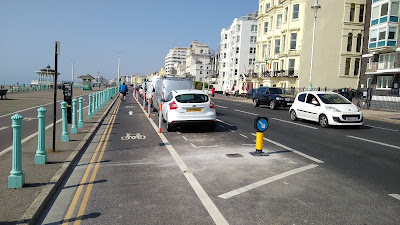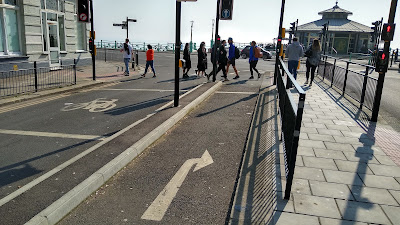Last week, I talked about BTN Bikeshare and the Maderia Drive pop-up cycling scheme in the City of Brighton & Hove. This week is the second of the two-part report from the city and where I look at another pop-up cycling scheme and a new* type of crossing.
The pop-up cycling scheme was another response to the Pandemic and provided a much needed capacity boost to the west of the Place Pier. The scheme starts on the A259 Kings Road just outside the Brighton Centre and runs for 1.8km west to to the junction of the A259 Kingsway and Fourth Avenue. As with Madeira Drive, this was already a long established cycle route, but in this case, it was marked out on the wide footway running next to the A259 in road markings and red surfacing.
The photograph above is from 2014 and shows the general standard of the sea front cycle track here which is a red asphalt strip bounded by raised markings. There is lots of shared space at crossings and it is really too narrow for social side by side cycling as you can see in this very shaky bit of footage I shot in 2014 - personal video has come on leaps and bounds in those eight years!
The pop-up scheme essentially takes nearside carriageway space in the westbound direction and adds a wand and car parking protected cycle lane (below).
The existing cycle track on the wide path has been made one-way eastbound, which means people are kind of cycling on the "wrong" side. In fact, you'll still see a few people on the cycle track cycling the wrong way because it is either more convenient for them (having joined from some attractor), it's what they are used to, or they still want to be away from traffic.
This slightly odd arrangement means that no alterations were required to existing traffic signals and bus stops, so for a pop-up scheme it makes perfect sense because it would have otherwise meant a large investment for something that could have only had a short life.
The general car parking retained on the route has been very simply dealt with. Road markings give a lead in to the bays, a keep right arrow on a bollard is affixed to the carriageway for drivers who cannot see parked cars and there is a buffer between the parking bays and cycle lane with orange wands to stop encroachment.
For people leaving cars on the nearside, the buffer is a touch tight and there is a dooring risk, but people cycling will generally be to the left or centre of the lane and I don't see it as a problem; at least I didn't see any problems when I cycled it.
There are runs of blue badge parking bays and they have been dealt with in two ways. The first way is like the general car parking, but dropped kerbs and mini-zebra crossings have been provided over the pop-up cycle lane and adjacent cycle track (above). There is no tactile paving associated with them as they are not crossings in the sense of having to cross the road and so it's more about dropped kerb accessibility. Strictly speaking though, mini-zebras should have tactile paving and so personally, I don't think these should be mini-zebras at all.
The other way has the blue badge bays at the kerbside because some people benefit from the raised level a footway gives. The cycle lane passes to the right which isn't ideal, but again, it is a pragmatic solution for now that gives disabled people using cars some options.
One other compromise is that bus stops are in the line of the cycle lane (above) and so that's a conflict point where buses are pulling and where cyclists would have to move out into traffic to pass a stationary bus. Floating bus stops would have been possible, but again, there is a cost involved.
Perhaps the most important lesson from the scheme is that road space has now been reallocated and the world hasn't ended. This means there is now the width from the edge of the pop-up cycle lane to the edge of the cycle track to play with to create a proper two-way cycle track. If designed carefully, this means the car parking can be floated, but with a decent "landing" island. It also means that the bus stops and pedestrian crossing landings can be floated which gets rid of shared areas.
Sea fronts are handy for two-way cycle tracks as any junctions on the sea side are generally limited to beach access points or loading for attractions. Getting the buffer between the cycle track and the carriageway then frees it up for landings and landscaping such as can be seen in the photograph above from Great Yarmouth. One thing that does need to be thought about is access to side roads and frontages on the non sea side and that is the general issue with two-way cycle tracks anywhere. Here's a video of a ride along the pop-up lane and one-way track.
On the subject of getting people across the road from a two-way cycle track into side roads, this is something we can design for and at the junction of the A259 Kings Road and West Street, a signalised junction has considered cycling quite well.
In the introduction, I said "a new* type of crossing" and this is the footnote to the "*". This junction incorporates parallel signalised cycle crossings of the A259 (above). The A259 is a dual carriageway here and on the southern side, the cycle crossings resemble the "sparrow" style crossings which have started to appear; notably in Greater Manchester.
Sparrow is not an official Department for Transport (DfT) name for the crossing, this was coined by Sam, a campaigner from Manchester and it is short for Signalised PARallel crossing, following the avian naming convention we have for other signalised crossings. Strictly speaking, a sparrow crossing is standalone affair with zig-zags, a layout which actually needs special authorisation from the DfT because they forgot to make it a standard layout.
In fact, we have been putting sparrow style cycle crossings in junctions for years and that's why I'm cheekily suggesting it's not a new concept, but the standalone nature and zig-zags is where the term was coined, so let's go with it!
On the northern side of the A259, cycle traffic heading north into West Street merges with general traffic, but getting there continues to be separated in time. For southbound cycle traffic joining the cycle track, there is a protected right turn pocket (above) which has its own traffic stage. As one leaves the pocket, one turns right and then immediately left to complete the crossing. It's a bit wiggly, but very much in the spirit of a sparrow and it works fine.
I was a little concerned about the offside nature of the West Street exit, but traffic volumes were low at the time of the visit and it seemed fine. Maybe West Street needs redesigning for protected cycling in any case because it is the most direct route between Brighton Station and the sea front.
The southern side of the crossing is into a shared area and so ultimately it would be good to separate that all out so people have their own space and the tramline paving forming the ramps to the carriageway are not a good location for them because they can become slippery in the wet. This is, however, a perfectly useful crossing which features in the video which I shall leave you with this week.









No comments:
Post a Comment